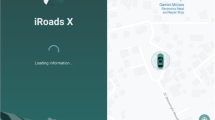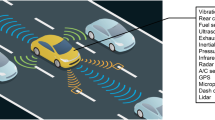Abstract
Detecting road potholes and road roughness levels is key to road condition monitoring, which impacts transport safety and driving comfort. We propose a crowdsourcing-based road surface monitoring system, simply called CRSM. CRSM can effectively detect road potholes and evaluate road roughness levels using hardware modules mounted on distributed vehicles. These modules use low-end accelerometers and GPS devices to obtain vibration patterns, locations, and vehicle velocities. Considering the high cost of onboard storage and wireless transmission, a novel light-weight data mining algorithm is proposed to detect road surface events and transmit potential pothole information to a central server. The central server gathers reports from multiple vehicles, and makes a comprehensive evaluation on road surface quality. We have implemented a product-quality system, and have deployed it on 100 taxies in the Shenzhen urban area. The results show that CRSM can detect road potholes with 90 % accuracy, with nearly zero false alarms. CRSM can also evaluate road roughness levels correctly, even with some interferences from small bumps or potholes.











Similar content being viewed by others
Notes
There are various ways to deal with the problem of GPS signal being temporarily unavailable. For example, the Siemens car navigation system uses Kalman filters and auxilliary sensors [16] for dead reckoning. To simplify the online data mining algorithm, we have used a simple interpolation method, instead of more sophisticated methods.
References
ABCChicago. Find a claim, reporting a pothole. http://abc7chicago.com/archive/5942405/
A synopsis on the current equipment used for measuring pavement smoothness. http://www.fhwa.dot.gov/pavement/smoothness/rough.cfm
Basharat, A., Gritai, A., & Shah, M. (2008). Learning object motion patterns for anomaly detection and improved object detection. In Proceedings of IEEE conference on computer vision and pattern recognition (CVPR).
Chen, K., Lu, M., Tan, G., & Wu, J. (2013). CRSM: Crowdsourcing based road surface monitoring. In Proceedings of IEEE/IFIP international conference on embedded and ubiquitous computing.
Christian, K., & Loannis, B. (2011). Pothole detection in asphalt pavement images. Advanced Engineering Informatics, 25, 507–515.
Dodds, C., & Robson, J. (1973). The description of road surface roughness. Journal of Sound and Vibration, 31, 175–183.
Dyer, J., Dyer, D., & Devore, J. (2009). Estimating international roughness index from noisy profilograph measurements. In Proceedings of IEEE instrumentation and measurement technology conference.
Eriksson, J., Girod, L., & Hull, B. (2008). The pothole patrol: Using a mobile sensor network for road surface monitoring. In Proceedings of international conference on mobile systems, applications, and services (MobiSys).
Hou, Z., Wang, K., & Gong, W. (2007). Experimentation of 3D pavement imaging through stereovision. In Proceedings of international conference on transportation engineering.
Jason, M., Claire, S., Stephen, M., & Denis, T. (2012). 3D laser imaging for surface roughness analysis. In International Journal of Rock Mechanics and Mining Sciences, 58, 111–117.
Kasun, Z., Chamath, K., Gihan, S., & Shihan, W. (2007). A public transport system based sensor network for road surface condition monitoring. In Proceedings of the 2007 workshop on networked systems for developing regions.
Li, Q., Yao, M., Yao, X., & Xu, B. (2010). A real-time 3D scanning system for pavement distortion inspection. Measurement Science and Technology, 21(1), 15702–15709.
Lin, H., Chuang, J., & Liu, T. (2011). Regularized background adaptation: A novel learning rate control scheme for Gaussian mixture modeling. IEEE Transactions on Image Processing, 20, 822–836.
Lou, S., Wang, Y., & Xu, C. (2007). Study of calculation of IRI based on power spectral density of pavement surface roughness. Journal of Highway and Transportation Research and Development, 24, 12–15.
Mandic, D., Golz, M., Kuh, A., Obradovic, D., & Tanaka, T. (2008). Signal processing techniques for knowledge extraction and information fusion. Berlin: Springer.
Prashanth, M., Venkata, N., & Ramachandran, R. (2008). Nericell: Rich monitoring of road and traffic conditions using mobile smartphones. In Proceedings of international conference on embedded networked sensor systems (Sensys).
Semiha, T., & Huseyin, A. (2005). A study of random vibration characteristics of the quarter-car model. Journal of Sound and Vibration, 282, 111–124.
Tan, G., Lu, M., Jiang, F., Chen, K., Huang, X., & Wu, J. (2014). Bumping: A bump-aided inertial navigation method for indoor vehicles using smartphones. IEEE Transactions on Parallel and Distributed Systems, 25(7), 1670–1680.
US Federal Highway Administration. 2010 status of the nation’s highways, bridges, and transit: conditions & performance. http://www.fhwa.dot.gov/policy/2010cpr/index.htm
Wang, Y., Yeh, C., Young, H., Hu, K., & Lo, M. (2014). On the computational complexity of the empirical mode decomposition algorithm. Physica A: Statistical Mechanics and its Applications, 400(15), 159–167.
Watts, G. R., & Krylov, V. V. (2000). Ground-borne vibration generated by vehicles crossing road humps and speed control cushions. Applied Acoustics, 59, 221–236.
Wu, Z., & Huang, N. (2009). Ensemble empirical mode decomposition: A noise-assisted data analysis method. Advances in Adaptive Data Analysis, 1, 1–41.
Xu, D., Mohamed, A., Yong, R., & Caporuscio, F. (1992). Development of a criterion for road surface roughness based on power spectral density function. Journal of Terramechanics, 29, 477–486.
Yang, S. (2006). Technical code of maintenance for urban road CJJ36-2006. Beijing: China Architecture and Building Press.
Yu, B., & Yu, X. (2006). Vibration-based system for pavement condition evaluation. In Proceedings of international conference on applications of advanced technology in transportation.
Yu, X., & Salari, E. (2011). Pavement pothole detection and severity measurement using laser imaging. In Proceedings of IEEE international conference on electro/Information technology.
Zhang, Y. & Ma, R. (2009). A study of pavement roughness measurement system based on laser ranger finder. In Proceedings of international conference on image analysis and signal processing.
Acknowledgments
Kongyang Chen’s work was supported in part by the SIAT Innovation Program for Excellent Young Researchers (201307). Guang Tan’s work was supported in part by NSFC Grant No. 61379135, Shenzhen Overseas High-level Talents Innovation and Entrepreneurship Funds No. KQCX20140520154115026, Shenzhen Fundamental Research Program under Grant No. JCYJ20140610151856733, and Guangdong Key Laboratory of Popular High Performance Computers & Shenzhen Key Laboratory of Service Computing and Applications Open Grant No. SZU-GDPHPCL201410. Mingming Lu’s work was supported in part by the NSFC under Grant 60903222. Jie Wu’s work was supported in part by NSF Grants ECCS 1231461, ECCS 1128209, and CNS 1138963, CNS 1065444, and CCF 1028167.
Author information
Authors and Affiliations
Corresponding authors
Rights and permissions
About this article
Cite this article
Chen, K., Tan, G., Lu, M. et al. CRSM: a practical crowdsourcing-based road surface monitoring system. Wireless Netw 22, 765–779 (2016). https://doi.org/10.1007/s11276-015-0996-y
Published:
Issue Date:
DOI: https://doi.org/10.1007/s11276-015-0996-y




